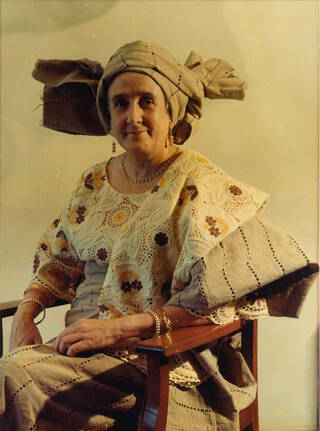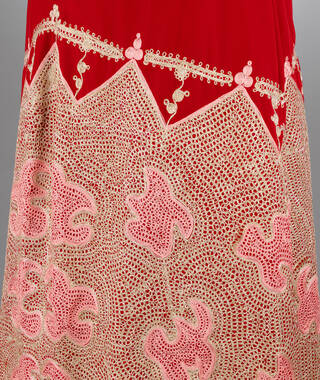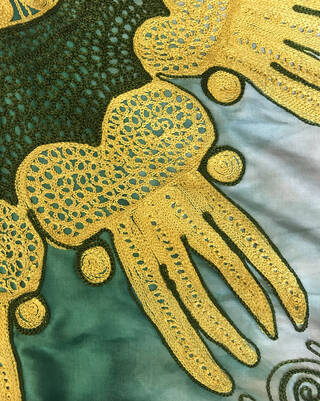What we wear gives an intimate insight into who we are, but also into the world we live in. The V&A's fashion collection is filled with the stories of people and their lives, accessed through their clothing. We also have larger collections from specific individuals – from socialite Emilie Grigsby, to banker Thomas Coutts. These capsule wardrobes document the sartorial choices of the wearer and provide a snapshot into a specific moment of fashion history. Professor Lalage Bown's collection is a new addition to this group, generously donated to the museum in response to the Africa Fashion call-out in 2022.
The woman behind the clothes

Born in Surrey on April 1st, 1927, Lalage Jean Bown OBE (1927 – 2021) was an adult education specialist and women's literacy advocate of white British heritage. Bown studied Modern History at the University of Oxford, receiving an MA in 1949, before moving to Ghana aged 22 to teach at the University College of the Gold Coast. She spent much of her career working to establish and expand adult education programs in Ghana, Uganda, Zambia and Nigeria, with a particular focus on the empowerment of women through literacy. She was also instrumental in promoting the incorporation of work by African authors into university curricula, which led to the publication of her book Two Centuries of African English in 1973.
Bown lived in Africa between 1949 and 1981, when she left to become the Head of the Department for Adult and Continuing Education at the University of Glasgow. A woman of sartorial flair, she amassed a large wardrobe during this time and when she returned home, kept a significant amount of the clothes she had bought whilst living in Africa. Vehemently not a collector of, or expert in fashion, Bown's wardrobe comprises of pieces she loved and wore regularly. She typically purchased her clothes from popular local tailors and dressmakers recommended by her students, wearing the fashionable styles of the moment. Known for her fondness for clothes, she was also occasionally gifted pieces by friends and students.
Beautiful in Barkcloth
Busuuti, also known as gomesi, became a common form of dress for women in the Buganda kingdom in Uganda from the early 20th century. The busuuti is a floor-length wrapped dress, which can be made of up to six meters of cloth. It features a square neckline, short, puffed sleeves, two buttons at the neckline, and is tied with a sash. It is typically worn with a kikooyi or khanga (types of cloth) tied underneath to ensure the fabric does not stick to the body.

In 1956 Bown organized for the wife of the Ugandan Minister Amos Sempa to stay with a family friend whilst visiting England and was given this busuuti as a gift of thanks for her help. Made from barkcloth, is it an incredible example of everyday fashion in Buganda in the 1950s. Increasingly rare as a material, barkcloth was a fabric choice for busuuti's in the 1950s, particularly for daywear.
The Baganda of the Buganda kingdom have been making barkcloth for centuries and it is recognised as an ancient craft of the Baganda by UNESCO. The cloth is made from the inner bark of the Mutuba tree (Ficus Natalensis), which is harvested during the wet season and then beaten to give it a soft, fine texture. Barkcloth is historically worn by men and women in Buganda. Busuuti are still a popular choice for special occasions in Buganda although they are now worn in a variety of materials, with Hajat Zuliyati Bbosa noting, "First was barkcloth gomesi, worn by our mother, then Kaki gomesi/cotton gomesi which we wore in the 1960s, then toplain in 1970s then kikoy gomesi".
Dressed to impress: A grand boubou from Dakar
The boubou is a classic Senegalese garment worn by men and women. Traditionally custom-made, the boubou is created by folding a rectangular piece of fabric in half, creating a neck opening, and then partially sewing the sides. A woman's boubou has a large, rounded neck-opening. The 'grand boubou' came into fashion after World War II, and required a larger amount of fabric, hence the name. Women usually wear a boubou with a pagne – a wrapped skirt, and a head-tie.

Made in Dakar, Bown commissioned her grand boubou from a local tailor in 1966, and it was designed to make a statement. She visited Dakar a few times in the lead up to, and for, the Second International Congress of Africanists, of which she was the Joint Executive Secretary. She wore the outfit several times, at the opening ceremony hosted by Senegalese President Léopold Senghor, and one or two of the receptions in 1966 and '67.
Bown's grand boubou is made of light green organza which is machine-embroidered with silver flowers, and has a head-tie in the same fabric. It is accompanied by a dark green pagne, and sleeveless peplum top in a seersucker-style synthetic material. Boubous are historically made from cotton, but speaking of the synthetic organza used on her ensemble Bown explained that, "the under 'up and down' and the organza over-dress was the complete outfit worn in the streets by almost all the women of Senegal at the time. The colours varied, but they all wore that style. I simply asked the tailor to make me an outfit in the then-current style".
Stylish in Shade Thomas-Fahm

Known fondly as 'Nigeria's first fashion designer', Shade Thomas-Fahm is one of Nigeria's most prominent mid-century designers. Folashadé 'Shade' Thomas-Fahm studied fashion at St Martin's School of Art in London, before returning to Lagos in 1960 to open her boutique, Maison Shade (later Shade's Boutique). Championing Nigerian fabrics and silhouettes, Thomas-Fahm designed for the cosmopolitan, working woman. Her boutique swiftly became the go-to place for stylish people in Lagos and she counted diplomats and royalty among her regular customers.

Bown came across Maison Shade whilst working in Nigeria, first at the University College, Ibadan, then at Ahmadu Bello University, 1971 – 6, and finally at the University of Lagos, Nigeria, 1976 – 80; Institute of Development Studies. Trips to Maison Shade were always a treat reserved for special occasions – most notably in 1977 when she commissioned Thomas-Fahm to create an ensemble for her to wear to receive her OBE at Buckingham Palace. The resultant design is typical of the Thomas-Fahm aesthetic, embellished with heavy chain stitch embroidery with lurex thread on the neckline, sleeves and cuffs, designed to make an impression. Having lived and studied in London herself, Thomas-Fahm recalled the chill of the cold English weather and swapped her usual soft silks and airy cottons for a heavy red velvet. Thomas-Fahm designed the dress with a matching hat, styled to look like a gèlè (headwrap).
V&A curator, Elisabeth Murray, examines Lalage Bown's grand boubou and red velvet dress in detail:

Thomas-Fahm's work regularly draws on Yoruba culture and material techniques, which is illustrated in another dress in Bown's wardrobe – an adaptation of the Yoruba man's agbada robe made in the 1970s. Made from heavy duchess satin, tie-dyed grey and turquoise, it is decorated with yellow and green chain-stitch embroidery. The yellow embroidery references the Yoruba symbol Ooya, which represents the comb used by hair plaiters and is a recurring symbol in àdìrẹ cloth. It came with a matching hat in the same fabric which Bown later adapted into a drawstring bag.
Tie-dye fashion in Sierra Leone

Sierra Leone has a long history of tie-dye and batik dyeing. This process of dyeing is called 'gara' in reference to the gara leaves which come from indigo plants. Purchased at the Cheedonian Boutique in Freetown in 1994, this dress spotlights the use of gara dyeing in contemporary fashion in the 1990s. The dress itself is made from a single rectangle of cotton fabric which has been folded over and the sides sewn down. A neck opening has been cut in the central fold, and two ovals cut and sewn to create the arms of the dress, the exterior seams of which are left open to create a draped effect when worn. The form is an adaptation of the wide-sleeved robe common across West Africa, known also as a 'boubou', 'agbada' or 'kaftan'.

The cotton is patterned with a form of gara dyeing, using the 'taka' technique. Taka is the Mandinka word for tying and here refers to the practice of folding cloth into pleats which are then bound together and immersed in dye, resulting in a striped design. Gara is traditionally made with dyes from the indigo leaf and/or kola nuts, creating patterns in blue and/or ochre. Chemical dyes became increasingly popular in Sierra Leone from the 1960s and the variety of colours on Bown's dress indicates their use here.
Documenting fashion
Together these pieces, along with three other outfits from Bown's collection, form a time-capsule of fashion. Individually each piece speaks to a particular moment and style, every stitch and fabric choice ready to be scrutinised. Together they speak to one woman's sartorial choices, but also provide an interesting insight to the exchange of fashions across the African continent and globally, with certain references, such as the agbada-style robe, repeated in her wardrobe, perhaps both a personal favourite style to wear, as well as a popular silhouette in different areas.


